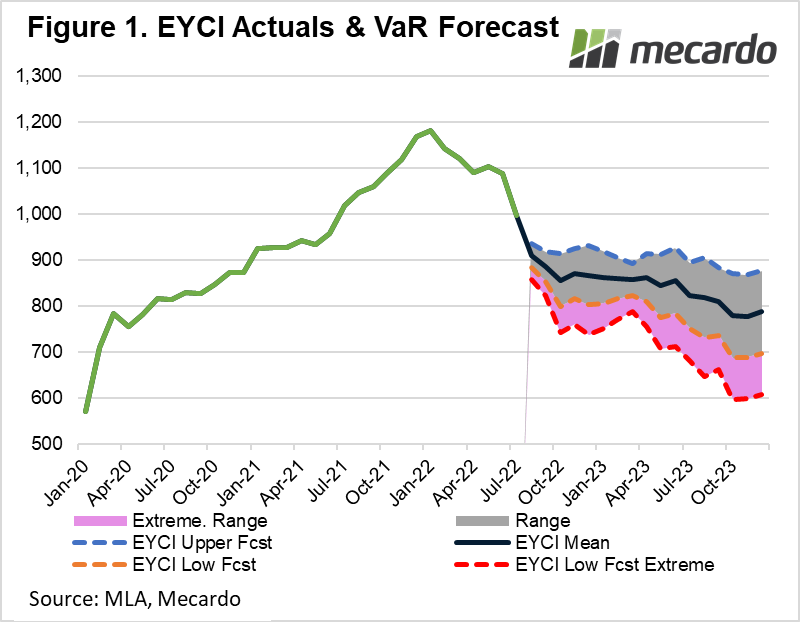Over the past two months we have seen the EYCI plunge from its mid-year high of 1,130¢/kg in early June to fall past the 1000¢ barrier, and beyond, clocking up a 17% decline so far. What could the future hold?
When making predictions about the future state of a market, all mathematical models utilize lessons and data from the past to one extent or another.
The Mecardo historical downside VaR model is no different, as it utilizes past data to determine forecasts of the lowest level, or price, that an asset is expected to reach within a given period, to a particular degree of confidence. Because of this, the model forecasts generally have a downward trend in them due to the fact that as time progresses, the potential for a sequence of many negative price movements tends to accumulate. (In other words, over longer periods of time, there are more opportunities for things to go wrong)
VaR is a technique we have borrowed from the banking and commodities trading sector. It is utilized as a risk management tool that attempts to measure how much the price of an asset may fall over time based on its previous performance, and is used as a trading decision making tool to limit the accumulation of positions in assets that could lead to an unacceptably high concentration of risk of loss.
The Mecardo downside historical VaR model forecasts that prices, if they continue falling could land in within the range of 802¢-931¢ during the month of December 2022.
If we look at the red extreme decline scenario line, the model suggests that a 22% fall to as low as 737¢/lg cwt could be on the cards if we were to get particularly risk averse, and pessimistic about the future.
The Mecardo VaR model also predicts that average prices for 2023 could range from 758¢/kg to 896¢/kg cwt.
General analyst sentiment about the market across the corporate advisory, banking and government sectors has been predominantly negative in recent times. When making livestock marketing decisions, add the view of your livestock agent, business partners plus your own considered view into the mix, and you’ll have a range of views to think about, and apply them to your own personal situation and needs as appropriate.
One thing is certain though, for the cattle market environment to take a turn for the better over the next year, a solid selection from the positive events listed below probably have to happen.
- An official return to La Niña, in summer, and a strong, sustained northern monsoon.
- Processor access to reliable labour to be renewed, with the labour and skills shortage situation resolving itself through backpackers or sustainable permanent migration.
- The market’s view of the FMD threat becoming less alarmist and nervous.
- US pastoral conditions improving substantially, switching their cycle into a rebuild phase again, and supporting export prices.
- The perception of the recession threat subsiding across global economies and confidence building again.
What does it mean?
The historical VaR EYCI price forecast model draws from trends observed in the past to provide some indicative guiderails as to where the price of young cattle could potentially fall to in the future. The model suggests that at least another 8-22% decline by December wouldn’t be out of the realms of possibility, given past performance.
Have any questions or comments?
Key Points
- Downward trend in the EYCI fueled by strong supply.
- Downside VaR model used to generate forecast EYCI price range.
- Forecast price range of 802¢-931¢/kg cwt for DEC-22.
Source: Mecardo
Data sources: ABS, MLA, Mecardo


